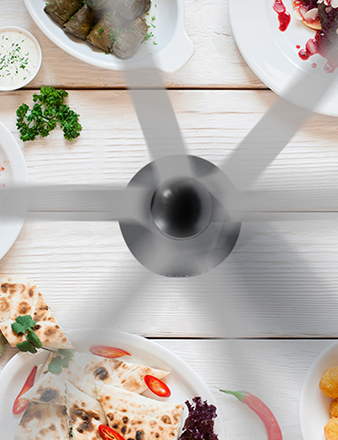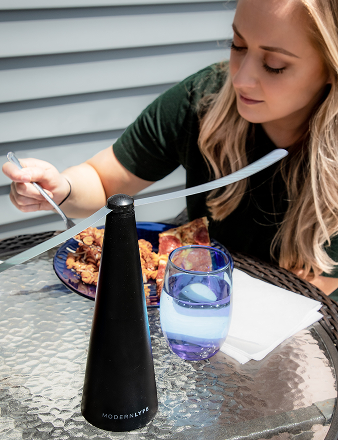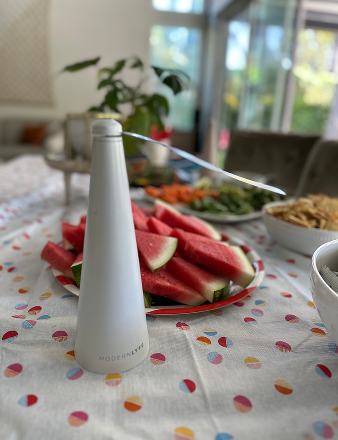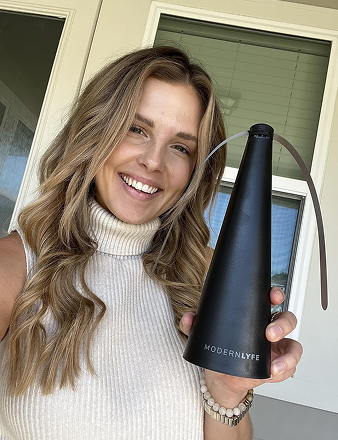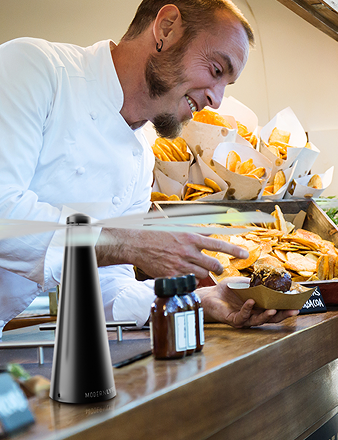We’ve all been there: the constant buzz, the swatting, the pure annoyance of flies in your space. A fly trap fan is the modern solution. It uses a soft UV light to attract flies and other flying insects, then a quiet fan pulls them into a hidden trap. It's a silent, chemical-free, and always-on way to keep your home or business fly-free.
Why Traditional Fly Control Fails
The old ways of fighting flies are messy and outdated. Sticky flypaper is just gross, leaving a visible graveyard of bugs dangling in your space. Chemical sprays fill the air with harsh fumes, raising safety concerns around kids, pets, and food.
Even the classic bug zapper has major flaws. The loud ZAP! is disruptive, and it can scatter insect fragments—the last thing you want in a clean kitchen or a quiet dining room. These methods require constant effort and create more mess. A modern fly trap fan is designed to solve exactly these problems.
This infographic shows the difference between old, messy methods and the clean, simple solution of a fly trap fan.
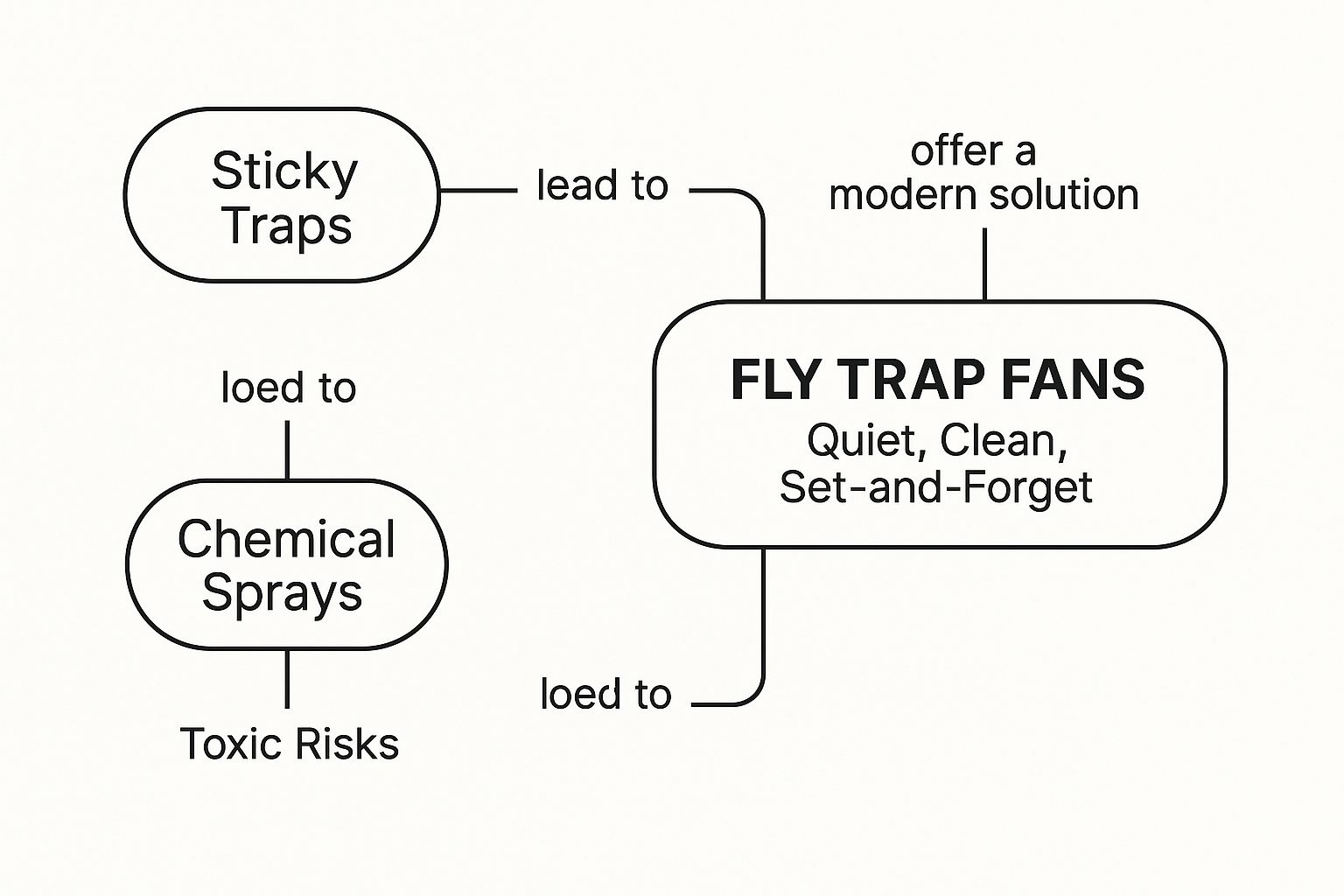
It’s a clear shift from high-maintenance hassles to a streamlined, set-it-and-forget-it approach.
A Smarter, Cleaner Way to Trap Flies
A fly trap fan was engineered to bypass common pest control issues. It doesn’t use sticky glues or harsh chemicals. Instead, its power comes from a smart two-part system: attraction and capture. It works quietly and continuously, offering a discreet and hygienic way to manage flying pests.
Here’s what makes it a game-changer:
- Set-and-Forget Operation: Plug it in and it gets to work. No daily maintenance required.
- Clean and Hygienic: Flies are captured inside the device, completely out of sight. No more unsightly mess.
- Quiet and Unobtrusive: The whisper-quiet fan blends seamlessly into any environment, from a peaceful home to a bustling cafe.
This modern approach turns pest control from a reactive headache into a proactive, clean, and effortless system. Reclaim your space without sacrificing peace, style, or safety.
How Fly Trap Fans Work
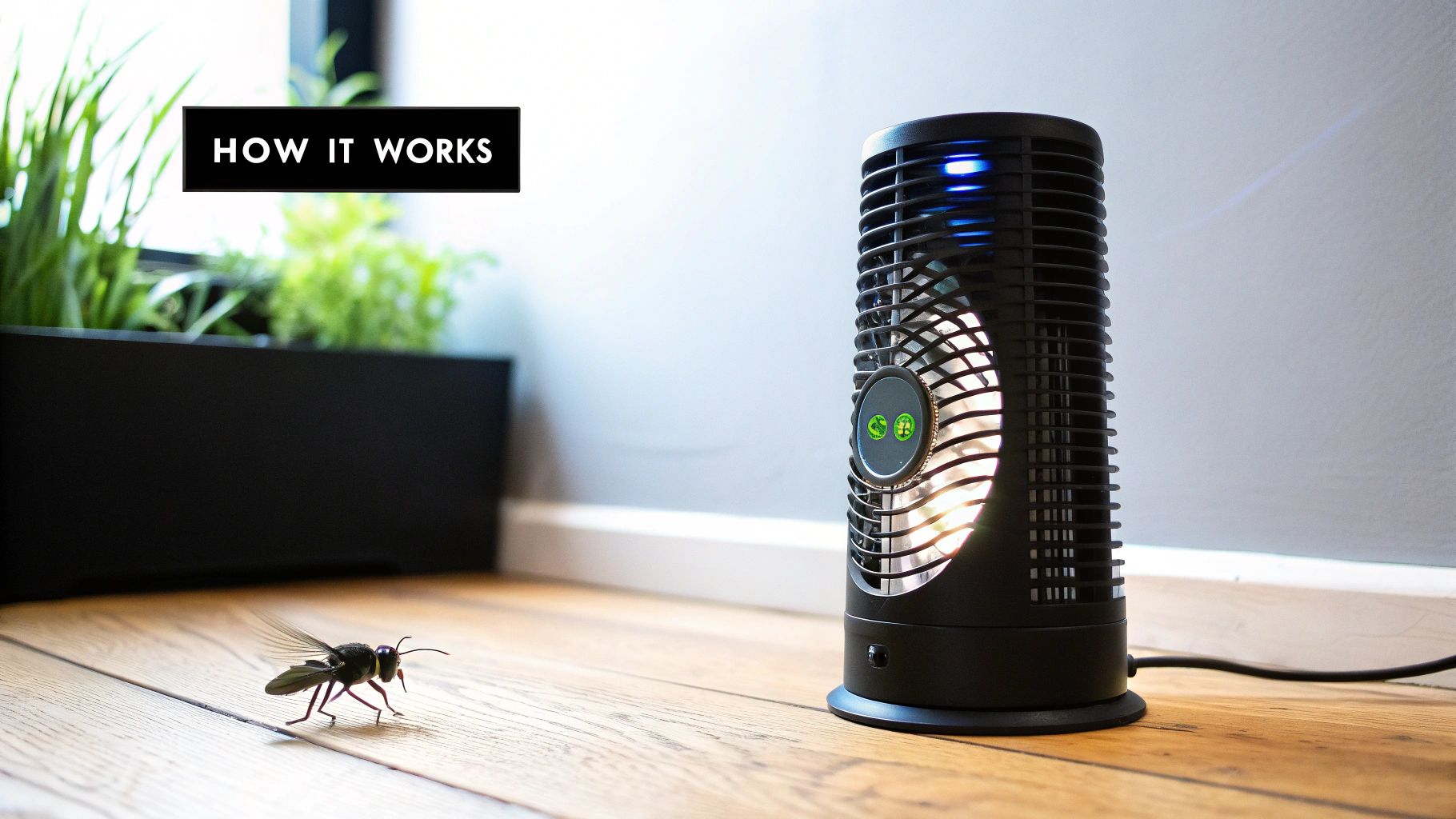
A fly trap fan isn't a bug zapper or another sticky tape. It’s a silent, automated guard for your space, working on a clever principle of attraction and capture. The process is a quiet, continuous cycle designed to run unnoticed in the background.
The device leverages a fly's natural instincts. It uses a specific wavelength of UV light that’s nearly invisible to us but acts as a powerful beacon for flies, gnats, and other flying insects. These bugs are phototactic, meaning they are instinctively drawn to certain light sources. A fly trap fan uses a UV bulb calibrated to produce the exact light they can't resist.
This light pulls them in from across the room. Once they get close, the second part of the system takes over.
The Two-Step Capture System
The brilliance lies in the seamless handoff from attraction to capture. This clean, two-step process is what makes the technology so effective.
First, the UV light acts as the bait—a constant, passive lure that doesn't rely on smelly chemicals. Once an insect flies close to investigate the light, it enters the fan's subtle vortex.
A quiet, low-power fan creates a gentle downward airflow. This current is too subtle for humans to notice but strong enough to pull in small insects like flies, gnats, and mosquitoes that venture too close.
This gentle pull is the second step. The fan guides the bug down into a hidden containment unit at the device's base. There’s no loud zap, no smell, and no escape. The capture is both silent and completely out of sight.
This dual-action mechanism is why fly fans work so well. For a more detailed look, you can explore our guide on the effectiveness of different fly fans.
Inside the Trap
To understand the full picture, let’s break down the key components and their functions.
Fly Trap Fan Components and Their Functions
| Component | Primary Function | Key Benefit |
|---|---|---|
| UV Light Bulb | Attracts phototactic insects. | Acts as a silent, chemical-free lure. |
| Internal Fan | Creates a soft downdraft. | Pulls insects into the trap discreetly. |
| Containment Unit | Holds captured insects. | Keeps pests hidden and contained hygienically. |
| Dehydration/Glue Board | Neutralizes trapped insects. | Offers a clean, no-mess disposal solution. |
Each part works in concert to create a system that's as effective as it is discreet.
Once inside, insects are trapped for good. Most models use one of two methods:
- Dehydration: The fan's constant, gentle airflow dehydrates the trapped insects, neutralizing them cleanly without chemicals.
- Sticky Glue Boards: Other designs use a replaceable sticky pad at the bottom. When insects are pulled in, they land and get stuck.
Both methods are highly effective and happen entirely inside the device, hidden from view. You never have to see or touch the captured pests. The entire system is built for hands-off, continuous pest control.
Key Benefits of a Fly Trap Fan
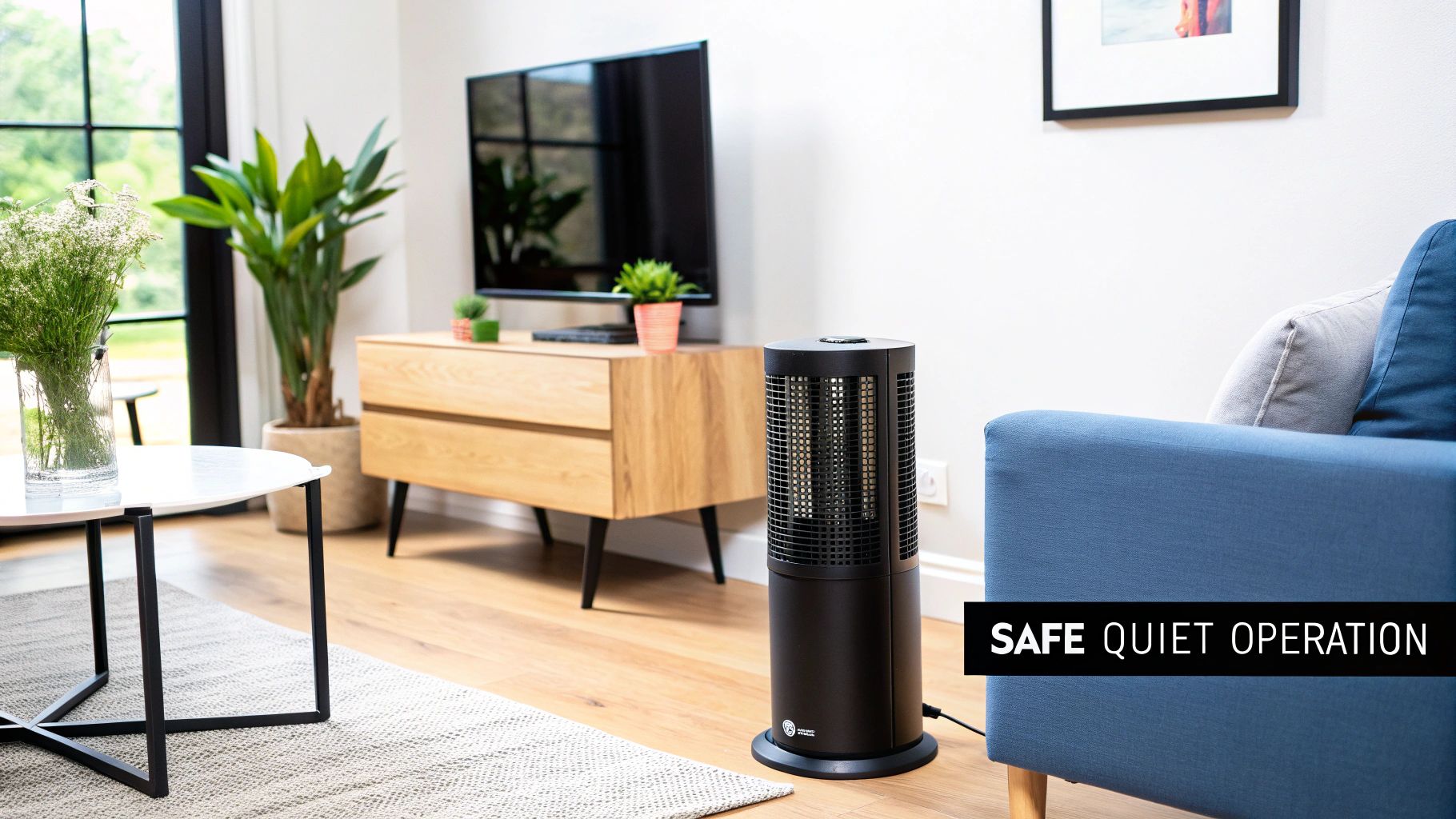
When dealing with flies, it's easy to get lost in options. Fly trap fans stand out because of how they work: safely, quietly, and with zero mess. These benefits make them the smart choice for kitchens, patios, and dining rooms where traditional methods fall short.
The biggest advantage is safety. Forget chemical sprays that leave a film on your counters or bug zappers with their unnerving electric grids. A fly trap fan is completely non-toxic and chemical-free.
That means you can place one on a picnic table full of food, set it up in a child's playroom, or keep it running in the kitchen without a second thought. It's a huge relief for anyone with kids, pets, or chemical sensitivities.
Silent and Discreet Operation
Nobody likes the loud ZAP of a traditional bug zapper. It’s startling and can ruin a peaceful evening. This is where a fly trap fan excels.
It’s engineered to be incredibly quiet. The internal fan produces a gentle hum—often softer than a refrigerator—that fades into the background. You can run it 24/7 in a quiet bedroom or a busy restaurant without causing a disruption. It gets the job done without making a noise.
The real beauty of a fly trap fan is its "out of sight, out of mind" approach. It solves the pest problem without creating a new visual or auditory one.
This quiet, understated performance is why they have become so popular in both homes and businesses. It's a solution that respects the atmosphere of your space.
A Hygienic Solution for Modern Spaces
Finally, let’s talk cleanup—or the lack of it. Sticky flypaper is disgusting, leaving a dangling collection of dead insects for all to see. Bug zappers can blast insect fragments into the air.
A fly trap fan is the cleaner alternative.
It pulls flies into a hidden compartment, trapping them neatly out of sight. You don't have to see a single captured pest until it's time to empty the trap. This clean, contained approach is a game-changer for maintaining a sanitary environment, which is critical in kitchens, cafes, and anywhere hygiene is a priority.
This demand for safer, cleaner solutions is part of a larger trend. The global fly trap market, valued between USD 294.1 million and USD 427.89 million by 2025, is growing as consumers seek smarter, eco-friendly pest control. To see the numbers behind this trend, you can explore the detailed market analysis on Future Market Insights.
Placing Your Fan for Maximum Effectiveness
https://www.youtube.com/embed/YUOQad6esE4
Even the best fly trap fan needs smart placement. Where you put the device is just as important as the fan itself. Think of it as security for your space—you want it posted at the entrance to stop trouble before it starts.
For your home, identify the main fly entry points. Set up your fan near doorways, open windows, and screened-in porches. The kitchen is another hot spot, but be strategic: place the fan away from food prep areas to lure flies toward the trap, not your dinner. For smaller setups, our guide on fly fans for tables offers great tips.
Proactive placement catches flies as they arrive, dramatically cutting down on the number you see buzzing around inside.
Optimal Placement for Commercial Spaces
In a business like a restaurant, hotel, or café, a fly trap fan is critical for health standards and customer experience. The right placement shows you take cleanliness seriously.
Place units near these key areas:
- Entrances and Exits: Your first line of defense against flies coming in with customers.
- Kitchen Pass-Throughs: A perfect spot to intercept pests moving between the kitchen and dining room.
- Near Garbage Bins: These areas attract flies, so a nearby trap is essential.
In professional settings, the goal is to create an invisible shield. The quiet, discreet operation of a good fan protects your establishment without disrupting the atmosphere.
Smart placement turns your fly trap fan from a simple device into a complete pest management system. It's about thinking like a fly and using their instincts against them.
This focus on effective pest control is driving industry growth. The market for flying insect light traps, including many fly trap fans, was valued at around $250 million in 2025 and is expected to grow by nearly 7% annually through 2033. This growth is fueled by business demand and technological advances. You can read the full research about these market trends to learn more.
Placement Dos and Don'ts Checklist
Follow a few simple rules to get the most out of your fly trap fan. Avoiding common mistakes can make a huge difference.
Placement Dos:
- Do place it in low-light areas. The UV light is more attractive to flies when it isn't competing with bright sunlight or overhead lighting.
- Do position it between entry points and areas you want to protect, like a dining table or kitchen counter.
- Do keep it running 24/7, especially during peak fly season, for constant protection.
Placement Don'ts:
- Don't place it directly above food. You want to draw flies away from your meal, not toward it.
- Don't put it in areas with strong drafts from A/C units or open windows, as this can disrupt the fan's airflow.
- Don't hide it. Ensure a clear line of sight for flies to see the light and for air to circulate freely.
How to Choose the Right Fly Trap Fan
Picking the right fly trap fan means matching the tool to the job. The right fan for a small kitchen is different from what a large restaurant patio needs. Getting this right is key to solving your fly problem.
Start With Your Space
First, determine the coverage area. This is the most important factor. Manufacturers measure this in square feet, telling you how much space a fan can effectively keep clear.
A compact fan might be perfect for a 150-square-foot office but will be useless in a 1,000-square-foot warehouse. Measure your room and ensure the fan you choose is up to the task.
Look for Features That Matter
Once you've sorted out the size, dig into the details. The capture mechanism and UV light source are critical.
Most fans use either a dehydration chamber or a sticky glue board. Dehydration is a clean, set-it-and-forget-it option. Glue boards are highly effective but need to be replaced regularly, like ink in a printer.
Don't forget about aesthetics. A good fly trap fan should do its job without screaming "I'm a bug trap!" Look for a design that blends with your décor, not one that becomes an ugly focal point.
Finally, consider long-term ownership. Two things are crucial:
- UV Bulb Lifespan: The UV light is the bait. Its fly-attracting power fades over time, even if the light still works. Plan on replacing the bulb every 6-12 months for best results.
- Energy Efficiency: This fan will run 24/7. A low-wattage, energy-efficient model might cost more upfront but will save you money on your electricity bill.
This focus on smarter pest control is fueling a huge market boom. The global fly traps market is expected to grow to USD 623 million by 2030, driven by consumer demand for better, greener solutions. You can dig into the numbers by checking out the latest fly trap market research.
By weighing these factors, you can invest in a solution that gives you lasting, no-fuss protection.
Keeping Your Trap in Top Shape
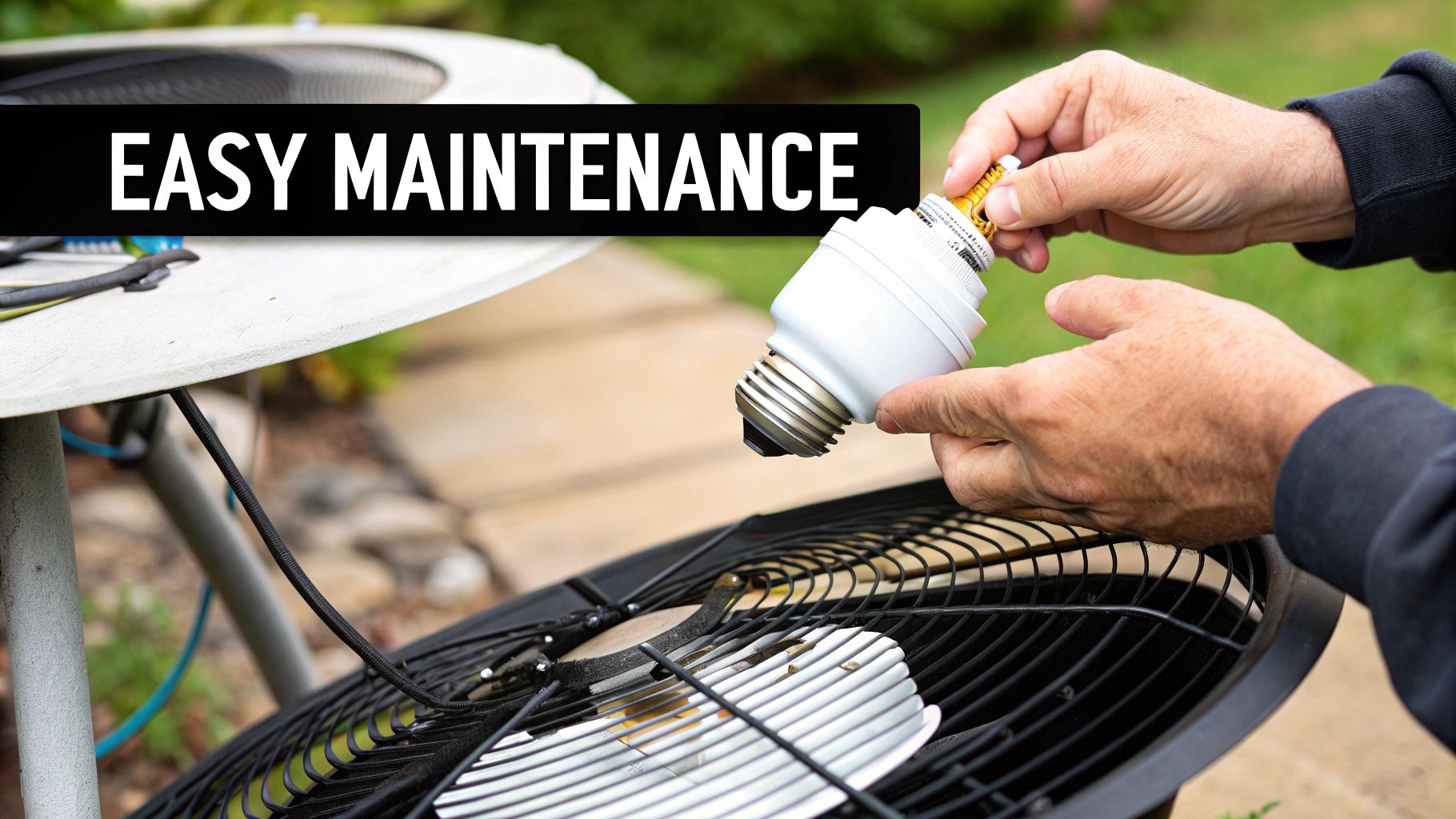
The good news is that maintaining a fly trap fan is simple. It's like changing the bag in your vacuum—a quick chore that makes a big difference. A little consistent upkeep ensures your device remains a silent, effective guard against flying pests.
The main task is managing the collection area. Since this is where captured insects end up, it needs regular attention to stay effective and hygienic. How often you do this depends on your model and the severity of your fly problem.
Tending to the Trap
How often should you empty the trap? It all depends on how many flies you're catching. A busy restaurant kitchen in summer will need more frequent checks than a quiet home office in winter.
As a general rule, check it every 2 to 4 weeks. This habit prevents the trap from overfilling and ensures it’s always ready to catch more insects.
- Models with Glue Boards: Simply slide out the old board and insert a fresh one. The process is clean, mess-free, and takes less than a minute.
- Models with Dehydration Trays: Unclip the bottom tray, empty the contents into the trash, and give it a quick wipe before snapping it back on.
Remember: a full trap can't catch more flies. Staying on top of this simple task is the secret to uninterrupted performance.
This small effort pays off by keeping your environment consistently fly-free.
Swapping Out the UV Bulb
The UV bulb is the lure—the heart of your trap's attraction system. Over time, its power fades. While the bulb may still light up, the specific UV wavelength that draws in flies weakens after months of constant use.
To keep the trap working like new, replace the UV bulb every 6 to 12 months. This ensures the light remains a powerful beacon for flies. Changing the bulb is usually a simple, tool-free job, just like replacing a standard lightbulb. This one step revitalizes your fan’s luring power, making it as effective as day one.
Fly Trap Fan FAQs
It’s normal to have a few questions. Let's tackle the most common ones so you can feel confident choosing a fly trap fan for your space.
One of the first questions people ask is about safety, especially around children and pets.
Are Fly Trap Fans Safe for Pets and Children?
Yes, absolutely. Safety is a key feature. Unlike chemical sprays or zappers, a fly trap fan uses no pesticides, toxins, or dangerous high-voltage grids. The process is purely mechanical.
A gentle light attracts insects, and a quiet fan pulls them into a self-contained trap. Once inside, they're out of reach, making it a worry-free solution for households with curious kids and pets.
Do They Work on Other Bugs Like Mosquitoes?
Yes. While designed for flies, the UV light attracts all sorts of phototactic pests. That means they are also effective at catching gnats, moths, and mosquitoes.
The fan is typically strong enough to pull in these smaller insects, making it a great all-in-one device for most flying annoyances. For an extra edge, learn about the best fly trap liquid attractants to use alongside your fan.
The core technology—UV light paired with a fan—is versatile enough to handle more than just flies, offering broader protection for your space.
This multi-pest capability adds to their value, making one device a more complete bug control system.
Is a Fly Trap Fan Noisy?
Not at all. They are designed to be whisper-quiet. Most models produce a soft, low hum comparable to a small computer fan or a modern refrigerator.
This quiet operation means you can run it 24/7 without it being a distraction. Put it in your bedroom, office, or living room—it will do its job without anyone noticing.
Ready to reclaim your space with a silent, stylish, and effective solution? The MODERN LYFE fly fan offers the perfect blend of design and function to keep your gatherings pest-free. Shop now at MODERN LYFE and experience the difference.

